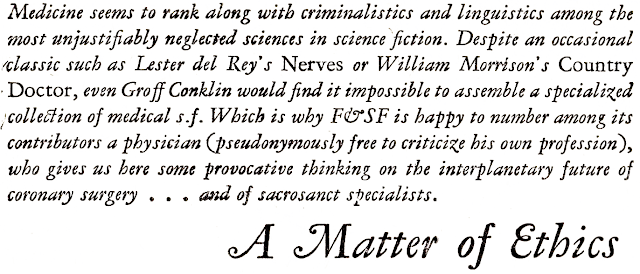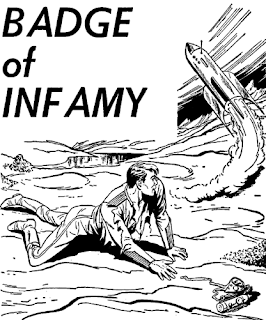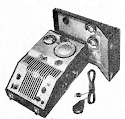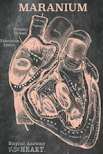 |
| 1987 edition |
First Born. Continuing with the remaining stories in Great Science Fiction About Doctors, I'll start with "Out of the Cradle, Endlessly Orbiting" (1959) by Arthur C. Clarke. In this story, Clarke begins in the future year 2000 and explicitly states that in this imagined future, Wernher von Braun is still alive. However, here in the real world, Dr. von Braun (he was awarded a physics doctoral degree in 1934) died in 1977. In "Out of the Cradle", Clarke also explicitly states that in his imagined future, the 88 year-old von Braun lives on the Moon. Clarke made other "predictions", such as naming the first man to orbit the Moon (Jerry Wingate).
 |
| the birds and the bees... on the Moon |
Nuclear Rocketry. "Out of the Cradle, Endlessly Orbiting" is told from the perspective of a Russian man (born in 1932) who was in charge of that mission to Mars. Readers learn that some sort of nuclear propulsion was developed for the manned mission to Mars and Clarke imagined that all the nations of the world would cooperate to send human colonists to Mars.
The story is about the first human to be born on the Moon (in 1977). Yes, I suppose there may have been a medical doctor present at that birth, but the blessed event takes place "off screen". I've previously described Conklin's infatuation with Clarke, frequently including his stories in anthologies, even when doing so made little sense. 🤷
 |
| interior art for "Family Resemblance", featuring the pig baby. |
This Little Piggy. Also included in Great Science Fiction About Doctors was "Family Resemblance" (1953) by Alan E. Nourse. This is a joke story and in his introduction, Conklin admits that it is not really science fiction. Some young doctors play a joke on a nurse, placing a piglet in a hospital nursery.
Related. Nourse published a novel called The Bladerunner which lent its title to the movie known as Blade Runner. I've never read Nourse's novel.
 |
| 1977 Ace Books edition |
Nuclear War. Also in the April 1953 issue of Astounding Science Fiction, P. Schuyler Miller reviewed Star Man's Son by Andre Norton. It is interesting to see Norton referred to as "Mr. Norton" and called "he". I don't know when it became common knowledge that Norton was a woman originally named Alice Mary Norton. I once owned a copy of Star Man's Son that was published under the alternative title Daybreak: 2250 A.D. (see the image to the left).
We all have swords. 45 years later, I still remember reading Daybreak: 2250 A.D. and being intrigued by the possibility that mutated humans (the story is set after a nuclear war) might develop telepathic abilities. Even the big mutated cat (Lura) is telepathic. Also included in the story are mutated rodents who can use tools. Related Rodent: see "Flowers for Algernon".
 |
| Figure 0. Editor's introduction for "A Matter of Ethics" as appearing in the November 1954 issue of The Magazine of Fantasy and Science Fiction. "Nerves" and "Country Doctor" are discussed below. Linguistics in science fiction: The Languages of Pao. |
 |
| in the Ekcolir Reality |
I'm a sucker for stories about mysterious peoples living secretly among us. However, "The Brothers" is overly long and tedious and is fantasy, not science fiction. 😢
Nerves. I've previously tried to read "Nerves" (1942) by Lester del Rey. The two standard Sci Fi plots for authors wanting to write about nuclear energy are already mentioned above on this page. 1) Clarke's story "Out of the Cradle, Endlessly Orbiting" assumes that nuclear powered rockets would take humans to other planets. 2) Norton's Star Man's Son concerns an imagined nuclear war that destroys civilization.
 |
| Nuclear Drama™; interior art by Paul Orban |
Magic Hormones. I've previously commented on "Helen O'Loy" by Lester del Rey which was one of the first stories about robots that I ever read and featured a robot who was equipped with the electronic equivalent of hormones.
 |
| Hi Tek™ doctoring |
Of course, a realistic account of a topic such as nuclear medicine would have been too boring for Lester del Rey, so he wrote about an imaginary nuclear accident. This approach to telling a story about a nuclear isotopes industry is the equivalent of clanking murderous robots that were popular in early Sci Fi stories.
There is a whole team of medical doctors in "Nerves". Readers are first introduced to Dr. Roger T. Ferral, the Physician in Charge at a sprawling nuclear plant run by National Atomic Products Co. Inc.
 |
| These smoking hot nuclear doctors sure have a nerve. |
If you look on the interwebs, you'll find reviews of "Nerves" that state how Rey was a visionary for predicting the horrors that would come from nuclear power. I'll leave it as an exercise for the reader to count how many people were killed by 1) smoking tobacco and 2) by the nuclear power industry in the past 80 years.
 |
| Figure 1. Feldman's new life on Mars |
Tobacco companies paid people in Hollywood to promote tobacco use and even scientists were paid to lobby in support of deadly cigarette smoking. I've long wondered if Sci Fi magazines and writers for pulp magazines were bribed to include cigarette smoking in their stories. I suppose it is also possible that old Sci Fi story tellers were simply addicted to nicotine and they found it natural to write about their imagined fictional nicotine addicts.
 |
| Figure 2. Christina Ryan. |
More Magic Hormones. Lester del Rey informs readers that the only reason there is commercial spaceship traffic between Earth and Mars is because there are lucrative "plant hormones" that get shipped from Mars to Earth.
 |
| Driving on Mars... who needs air? |
 |
| image source |
Brakatine? Dr. Feldman discovers that to cure the Mars Plague, all you need to do is smoke "brakey weed", something that grows only on Mars. The colonists on Mars declare independence, but promise to sell Earth all the brakey weed that is needed to stop the Plague. Since the magical weed smoking cure saves the life of Christina, she stops trying to get Dr. Feldman convicted of doctoring without Medical Lobby sanction and everyone lives happily ever after.
 |
| more moon medicine in the Ekcolir Reality |
"William Morrison" was a pen name for Joseph Samachson who had training as a scientist. I've previously commented on his story "Star Slugger", a story about playing baseball on Mars.
The Moon Doctor. Dr. Meltzer is sent inside the ginormous creature from Ganymede. Meltzer helps the beast give birth and so he becomes famous. That's all there is to this silly story, and I'm not surprised that Conklin failed to include "Country Doctor" in his anthology about doctors.
 |
| Interior art for "Bad Medicine". |
There is no doctor in this story and the "bad medicine" is the herbal tonic from Mars.
 |
| in the Ekcolir Reality |
Two Humans To Save. In the end, the alien doctor does a fine job of reconstructing Margaret and she discovers that her new body is actually better than the original.
For "A Matter of Ethics" by Clifton Dance, readers are back in the same boat as for Dr. Feldman (above) and his struggle against the authoritarian Medical Lobby.
 |
| in the Ekcolir Reality |
Magic Metal from Mars. In Jack Vance's novel The book of Dreams, the ruling council of the Institute shares a secret. They manipulate the membership of the Institute for their own secret purpose. Similarly, in "A Matter of Ethics", the members of the Intergalactic Board of Mural Cardiosurgery share a secret. When Board president Dr. Mendez is dying after a heart attack, he shares the secret of a magical metal with Dr. Colby in order to save his own life.
The Medical Secret. If your surgical scalpel is made out of the magical metal Maranium then your heart surgery will be much more successful! In order to promote their own economic advantage, the Board does not share this medical secret with any other doctors, even their trainees such as Colby. However, once he knows the secret, Dr. Colby shares that secret with all doctors in the Galaxy and breaks the monopoly of the Intergalactic Board of Mural Cardiosurgery. |
| Secrecy in the Ekcolir Reality. |
 |
| Figure 3. Interior art by Diehl |
Magical Pets. Maybe "Bolden's Pets" (1955) by F. L. Wallace is some kind of alien telepathy story. There are doctors and other medical personnel in the story, but they accomplish nothing when Bolden becomes sick with the Bubble Death which is caused by an alien microbe that attacks the nervous system. Lucky for Boulden, the natives of planet Van Daamas know a cure, which is why they always keep on hand some of the little furry "pets" like the one shown in Figure 3. These pets can magically transfer "energy" into the nervous system of a person afflicted with Bubble Death, allowing them to fight off the disease.
 |
| image source |
"The Shopdropper" by Alan Nelson was originally published in the January 1955 issue of The Magazine of Fantasy and Science Fiction. That was the issue with "The Singing Bell", the first Wendell Urth story by Isaac Asimov. I previously incorporated another Urth story, "The Key", into one of my own stories. "The Shopdropper" is fantasy, not science fiction. 😞
"The Shopdropper" is about a pair of magic gloves that can turn you into a kleptomaniac. However, if you wear the gloves inside-out then you become obsessed with sneaking things into stores ("shopdropping"), not stealing. The story features Dr. Manly J. Departure, so the story does involve a doctor.
 |
| Figure 4. The editor's introduction to "The Shopdropper" in The Magazine of Fantasy and Science Fiction. |
 |
| in the Ekcolir Reality |
Aliens of Procyon. As told in "Emergency Operation", a microscopic alien (Dr. M'lo) must go inside a human patient in order to save the man's vision. "Emergency Operation" was first published by Arthur Porges in the May 1956 issue of The Magazine of Fantasy and Science Fiction.
Dr. M'lo is an Ilkorian, an intelligent creature the size of a red blood cell. Sadly, Porges never bothers to explain how the microscopic alien is able to think like a human and move through the insides of the patient like the miniature submarine in Fantastic Voyage.
 |
| Figure 5. In the Ekcolir Reality. |
 |
| Figure 6. Image source |
 |
| Nanotechnology in the Ekcolir Reality |
Porges published "The Fly" in the September 1952 issue of The Magazine of Fantasy and Science Fiction. Again, I ask: might "The Fly" have been inspired by "Surface Tension"? "The Fly" is a very short story about an alien spaceship that is, at first, mistaken for a fly. I love the idea of very tiny, even nanoscopic lifeforms, but neither Porges or Blish seemed to give serious thought to the practicalities and means of making very small beings who could think like we humans. Their stories read like magical fantasy with really small elves or fairies. More small aliens: see "Gandolphus".
 |
| recording audio on wire |
 |
| filament recordings |
 |
| iPods |
 |
| art by H. R. Van Dongen |
Next: part 3 of my search for interesting science fiction stories about doctors. The image to the left shows the Astounding cover illustration that went along with Murray Leinster's 1957 story called "Ribbon in the Sky". "Ribbon in the Sky" is a science fiction story 👏 with an interesting style of interstellar space-travel. That glowing smudge in the night sky is part of a futuristic method for terraforming a frozen planet; the titular "ribbon".
 |
| Kepler-452b by SteveReeves, available under the CC BY-NC-ND 3.0 |
I like to imagine that the image shown to the right might be a suitable depiction for one of Murray Leinster's imagined interstellar cargo ships of the far future. Such a spaceship can only land on a planet with the help of a "landing grid".
 |
| visit the Gallery of Movies, Book and Magazine Covers |


No comments:
Post a Comment